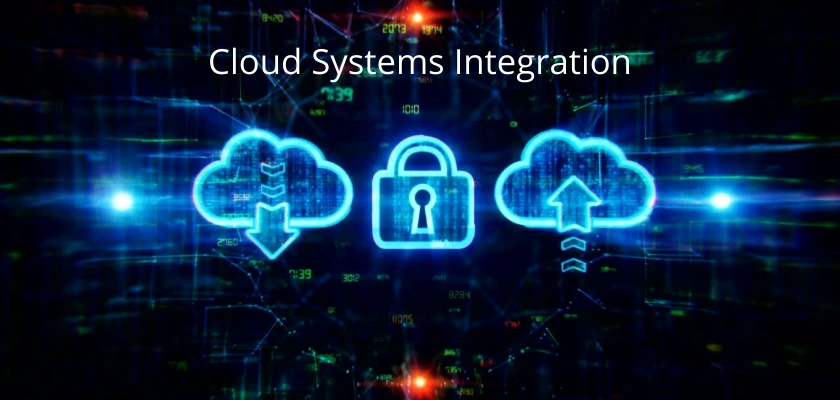
Things that we used to do on different tools and software are now done with a whole infrastructure. This is what Cloud Systems Integration is about. It brings innovative solutions for different aspects of life and Technology. The best part about cloud systems integration and cloud computing is that we can integrate old and new tools for fulfilling all the requirements along with getting extra features for more benefits.
Cloud systems integration has the potential to take your business to the next level. So, if you haven’t thought about moving to a cloud system, then it is time for you to do that. However, before that, there are many things that you must know about cloud systems integrations. Here we will be discussing everything you need to know about cloud systems integration.
What is Cloud Systems Integration?
Real-time exchange of data and information across different systems in an organized, efficient and reliable way is very important. While there is no other way of achieving this in real-time, Cloud systems integration makes it possible. We use a system of technologies and tools to connect different applications, IT environments and repositories to enable real-time data and information processing.
The best part about cloud systems integration is that you can either convert to the cloud or maintain a hybrid infrastructure to meet your infrastructure goals. Either way, your data and information will be shared and accessed across different devices on your infrastructure or network in real-time.
How can you implement Cloud Systems Integration?
If you have a business or an organization whose infrastructure still works on inefficient old-school techniques, then going for cloud integration is a better choice. However, it is not as easy a process as it sounds. There are different steps in the process.
(1) Navigating transition
The first step in this process of cloud integration will be navigating the transition in the infrastructure that you are planning to integrate. It is important to ensure that everything is seamless without any issues whatsoever. So, ensuring high-quality internet connectivity along with a real-time device network will be included in this step.
(2) Enabling collaboration among devices
This is the step where you will be moving towards the infrastructure itself. You need to write down all the operational requirements, goals and measure the hardware and software requirements for your cloud integration.
(3) Planning and implementing cloud systems integration
Doing another level deep into cloud systems integration is the area of careful planning about resource utilization. You need to make sure that there are no mistakes in this step because even the smallest mistakes can be very costly for your organization.
(4) IT Team training
The next step will be training of the IT team because without them it will not be possible for the organization to keep its systems running. Make sure to focus on different organizational needs for better training.
(5) Data management
Data management is one of the most important things to consider in the whole cloud integration process. This step becomes even more critical when you work with older systems.
(6) Security
With everything set up, you need to work also on security. There is not a lot to do in most cases because the cloud provider manages security for you. However, training employees at your end and making the overall network environment secure might be the task you have to carry out.
(7) Automation
The last thing in this process is automation. It is one of the best benefits of cloud systems integration. Automation is the step where you will be working on hardware along with employees. In this way, the organization will be saving both time and cost. After all of these steps, your cloud integration will be complete.
Benefits of Cloud Systems Integration
One of the many reasons cloud systems integration is becoming so popular and common is the long list of benefits they bring. These benefits can easily enhance the capabilities and operations of a business. So, here are a few of the benefits that you may get from cloud integration.
(1) Better reliability of your whole infrastructure
One of the most important things for a business is to have a reliable infrastructure. In the growing stages of a business, it is unbearable to face downtimes, crashes, and other issues. With cloud integration and added services, the reliability becomes better mainly because of the service provider’s AI-based backend and management services.
(2) Improvement in agility
Going with cloud systems integration enables a business to remain agile whenever it is about maintaining IT resources. It makes deploying different solutions and services easy. Similarly, it becomes easy for the business to manage the growing needs of its growing customer base.
(3) Better for the budget
Whether we talk about the small businesses or the larger ones, cloud integration brings cheaper services with a better experience and efficiency for everyone. It makes things better for the budget. There are many benefits included in making it budget-friendly, like no need for on-site hardware, a dedicated team to manage things, etc.
(4) Data compliance
Every company must store its customers’ data according to data compliance rules and laws. It might be difficult to implement with on-premises infrastructure. However, going with cloud systems integration makes it extremely easy. Built-in features ensure the best data compliance for everyone.
(5) Automation
Automation shows up here also as it is one of the best benefits of implementing cloud integration. It allows process automation, there are many cases where human error can lead to blunders on huge levels, but the process automation feature of cloud systems integration ensures no room for human error.
(6) Data synchronization
Every business has different use cases for its software infrastructure. So, it is necessary to use different techniques and options to synchronize data. Cloud integration ensures that the data and information on every device on the infrastructure is the same because of real-time working.
(7) Scalability
There is no need to worry about scalability issues if you have implemented cloud integration with your business. It allows you to easily manage the volume of data and the power and resources of the services you are getting. So, your business can easily scale without any time-consuming processes.
(8) Data modernization
Data modernization means easily moving the old data to newer systems. While the old-school software applications have no methodology, cloud integration comes with this as a built-in feature. Here, the modern data is used, transformed, and migrated with ease.
Different types of Cloud Systems Integration Services you may get
Cloud integration doesn’t have to be carried out by you. Some companies provide their cloud systems integration services. These services ensure to meet your integration needs and bring many other benefits. Some types of cloud systems integration services that you can use are;

IaaS
This helps an organization use its software or platform and integrate the cloud resources provided by the service producer. These services include servers, all the networking hardware, and storage solutions as well. It is also called Infrastructure as a Service.
PaaS
This is called Platform as a Service and here businesses get hosted platforms and cloud systems integration services. This type of service is the best choice for organizations that want to develop their tools and software. The experience here is easier because the service provider manages most things.
SaaS
SaaS stands for Software as a Service, and it includes full services that allow businesses to focus on core business things. Here, everything related to software and the cloud is under the service provider’s management. These services include management of everything, including resources, storage, application, and everything else.
See our teaching on Disaster Recovery as a Service (DRaaS)
Features of Cloud Systems Integration you need to know
Getting cloud systems integration for your business’ needs brings a lot of features that you might be missing otherwise. Below are some of them;
(1) Better connectivity experience
Cloud integration brings a better connectivity experience. While the old-school systems focus on manual sharing of data, cloud systems integration ensures to bring better connectivity with its built-in connectors for different resources like databases and file sources.
(2) Ease of use with easy management
With everything working together in real-time for the whole infrastructure of a business, it becomes easy to use things. Selecting efficient software and applications to cope with business’ needs also makes management easier. Whether we talk about routine tasks or integrations, everything is easier than older software solutions.
(3) Meets all digital requirements
One amazing feature of cloud integration is that it meets all the feature requirements for any business. It allows adding any features that a business needs. So, cloud systems integration makes it possible for every business to meet its digital requirements.
(4) Less time to market
Time to market is one of the most important things for businesses these days. It is because if you take a long time to bring a feature for the customers, your product might have already become a thing of the past. With increasing market competition, things become extremely better with cloud systems integration and faster time to market.
(5) Security
There is no match between the security of on-site infrastructure and the infrastructure that you achieve after cloud systems integration. It comes with AI working at the backend, management, and security solutions from top companies in the world. At the same time, experienced professionals are working on your services, and you can have the best security.
(6) Flexibility
Cloud systems integration bring more flexibility for businesses. It is hard to achieve this with older software solutions alone because every business has different requirements and use cases. However, with cloud systems integration, any business can have flexibility whenever a new feature is needed while deploying solutions.
(7) Higher competitive edge
Going with cloud systems integration at the right time sets any business ahead of the competition. This is the feature that brings a competitive edge to businesses because of having the latest technology by its side.
(8) Improved internal communication
Cloud systems integration improves the internal communications of any organization. With real-time data and information sharing, processing and synchronization, the communications between all the employees and management can be better.
(9) Better ROI
Cloud systems integration has a better Return on Investment in comparison with on-site solutions. Cloud integration services only include the cost of the resources. In the case of on-site infrastructure, you have to pay for resources, managing personnel and the hardware itself. So, the ROI is much better with cloud systems integration, considering all the features and benefits you get. It is also because of the reduction in operational costs.
(10) Better customer service
Any business can improve its customer service with the right cloud systems integration solutions. It will help in providing better support to the customers. Similarly, efficient functionality and data usage make customer retention better.
Why should you implement Cloud Systems Integration?
As we have seen so far in this teaching, the benefits of cloud systems integration are many. The main goal of cloud systems integration is to enhance business processes with better optimization and connectivity. With cloud-based data sharing, things become even more efficient. This is the reason for the booming growth of cloud systems integration, especially in the corporate world.
While some businesses go with dedicated cloud systems integration, some still focus on hybrid infrastructure. At the same time, IaaS, PaaS, and SaaS also bring amazing opportunities to enhance business processes. So, if your business is still on its old-school software, then it is time to upgrade because otherwise, you might be left behind in the competition.
Different Cloud Systems Integration Methodologies
The interesting fact about cloud integration is that it can be of different types. There might be cloud-to-cloud integration and cloud-to on-site integration, and sometimes you may use a mixture of both. However, in any of the cases, you have 2 basic cloud systems integration methodologies which are elaborated below:
Data integration
Data integration means the synchronization of the data repositories across different units. In this methodology, there are many different processes, including storing data, transforming data, converting data, etc.
Application integration
This integration is mainly about different systems and tools to enhance the overall functionality as well as flexibility. This is a rather complex thing because there are many business operations included in it. Things like request management also need to be dealt with carefully.
Challenges and Risks you may face with Cloud Systems Integration
Till now, we have been discussing only the bells and whistles of cloud systems integration. No doubt, there are many of them, but there are some blemishes and complexities as well. Moving towards your cloud integration experience without knowing the other side of the story will not just be right.
So, here we will elaborate on some of the challenges and risks that you may come across when dealing with cloud integration.
(1) Increased remote traffic
Cloud integration may make things efficient for businesses, but it also increases the load on different resources. So, it is necessary to carefully manage different resources and their utilization. The complexity increases because there are so many interconnections between so many things.
(2) Data accuracy
Depending on the data resources your business has, it can be a huge challenge to migrate or integrate the whole data volume with high accuracy. This is because making little mistakes is very easy, and mostly, they go unnoticed. However, they lead to huge blunders as a whole. So, designing comprehensive strategies for data migration specifically for your business requirements is also a challenge.
(3) Compliance shifts
Organizations usually skip the part where they have to understand different accountabilities. Some rules and laws may make cloud integration a little more complex for a business to implement.
(4) Migration complexities
Different software versions and differences work as a bottleneck for the cloud systems integration to work up to its full potential. Sometimes it is easy to deal with, but sometimes this can be a stubborn challenge that is almost impossible to deal with. Most of these challenges make no sense, but we still have to deal with them.
(5) Diversity in options
A major issue that many people face today is that there are no universal solutions for cloud integration. This is mainly because every business has different requirements and it needs software that fulfills different use cases. So, there are different tools and utilities needed for every cloud systems integration.
(6) Time-consuming
If you come across some issue, then it can be time-consuming to repair it. The diversity problem also affects this because a software update can take a long time before its release from the service provider. At the same time, it is not very easy to quickly resolve the issues yourself.
(7) Additional problems and bugs
The integrations overall are very complex. It may need you to develop some important technical skills and manage a team of dedicated professionals to deal with bugs and issues.
Conclusion
The competition among businesses these days has increased a lot. A huge credit for this increase goes to all the innovations in software and internet technologies. The right usage of the internet brings all businesses and organizations on a global platform. So, it is up to a business how it uses all the available opportunities and makes the best use of them.
Cloud systems integration might be the right opportunity for your business to make a difference and get ahead in the competition. So, get your requirements straight and start working on them before it is too late to empower your business operations with cloud integration.

